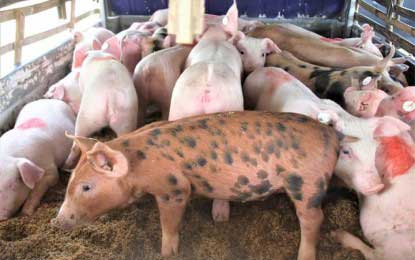
By Francis Allan L. Angelo
The first quarter of 2024 has seen a significant decline in hog and goat production in Western Visayas, according to a recent report from the Philippine Statistics Authority (PSA).
Hog production experienced a steep drop, with figures falling by 53.3% from 52,880 metric tons in the first quarter of 2023 to just 24,689 metric tons in the same period this year.
Similarly, goat production decreased by 19.6%, from 1,845 metric tons to 1,483 metric tons.
Contrastingly, the production of carabao and cattle showed positive growth. Carabao production increased by 8.8%, reaching 4,232 metric tons, while cattle production rose by 2.7%, totaling 4,828 metric tons.
Slaughterhouse Activity
The number of animals slaughtered in Western Visayas’ slaughterhouses mirrored these production trends.
Carabao slaughters decreased by 12.5%, with 9,719 heads processed, while hog slaughters saw a more drastic reduction of 36.7%, totaling 164,859 heads.
Conversely, cattle and goat slaughtering activities increased by 4.7% and 22.8%, respectively.
Regional Contributions and Inventory
Negros Occidental and Iloilo remain the top contributors to the region’s livestock inventory.
As of April 1, 2024, Negros Occidental accounted for 35.5% of the carabao inventory, with Iloilo following at 31.3%. For cattle, Iloilo led with a 27.1% share, followed by Negros Occidental and Antique.
Goat inventory was dominated by Negros Occidental, contributing over half of the region’s total, while the swine inventory saw Negros Occidental providing 61.4% of the total.
Poultry Sector Shows Growth
Despite challenges in livestock production, the poultry sector in Western Visayas displayed robust growth in the first quarter of 2024.
Chicken production increased by 9.7%, reaching 34,621 metric tons. Duck and chicken egg production also saw significant increases, with ducks up by 12.2% and chicken eggs by 15.5%. However, duck egg production decreased by 6.7%.
The number of chickens dressed in poultry dressing plants rose by 9.2%, amounting to nearly 14 million birds. Iloilo and Negros Occidental were the top provinces in chicken and duck inventories, reinforcing their pivotal roles in the region’s poultry sector.
Implications and Future Outlook
The decline in hog and goat production highlights the need for targeted interventions to stabilize and boost livestock farming in Western Visayas. Increasing productivity in this sector is crucial for meeting the region’s food demands and supporting local economies.
Efforts to enhance poultry production have shown promising results, indicating potential areas for investment and development. The growth in chicken and egg production suggests that poultry farming can be a viable alternative for farmers facing challenges in other livestock areas.
Government and industry stakeholders must collaborate to address the underlying issues affecting livestock production. Initiatives to improve breeding practices, enhance feed quality, and provide better veterinary services could help reverse the downward trends in hog and goat production.




















